Minecraft School of Witchcraft and Wizardry would be the most captivating Minecraft mod I’ve ever played… if it were a mod. But it’s not. Everything in the trailer above is built, engineered, and rendered within the game, and, excluding its signature texture pack, no additional modifications required.
What’s so impressive about Minecraft School is first its absolute scale, but also that, a few hours in, it’s easy to forget I’m playing Minecraft. The map takes the familiar, creative block-building game and turns it into something that plays much more like the old Harry Potter PC games of the early 2000s.
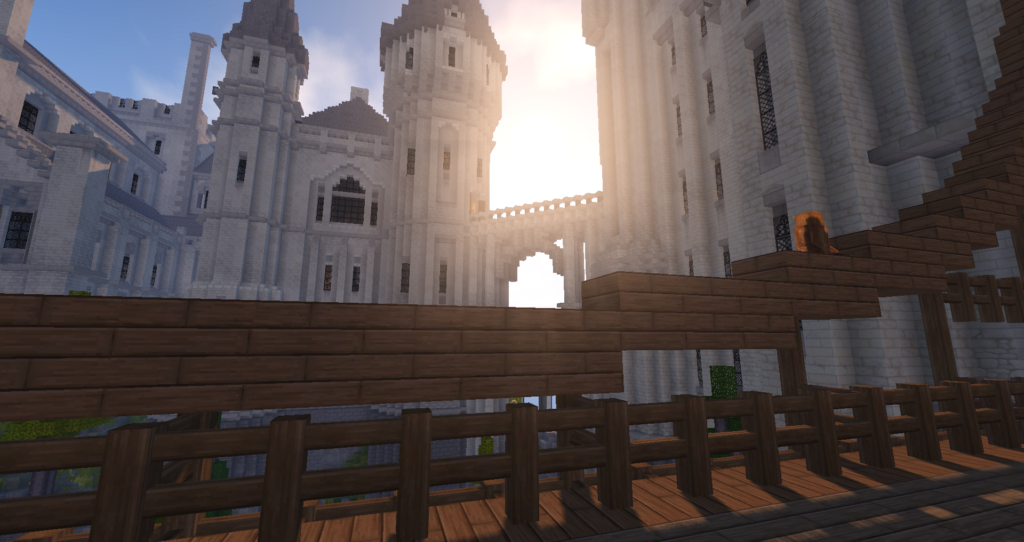
Make no mistake, this map was designed to act as a spiritual successor to those titles, games I hold a fair bit of nostalgia for. In that ambition, it succeeds. The core gameplay follows the same central path of its predecessors, going to classes at Hogwarts, learning spells, and then using those spells to solve puzzles and explore the castle.
Where Minecraft School deviates from the original Harry Potter games is its divorce from the perspective of their titular character. Where those previous titles had a responsibility to retell the story presented in one Harry Potter movie, with book-details sprinkled in, Minecraft School is unbound by that same restriction, which leaves its creators free to explore the Wizarding World universe through a more ambitious lens.

To be clear, the game isn’t completely rid of Harry Potter – he and the characters we’re most familiar with are all present, woven into this new plot. Their presence puts the map’s Hogwarts squarely within the Harry Potter years (Harry’s third year at the school in 1993, for the real fans), but the limitations end there.
When I loaded up the map for the first time, despite initially waking up on Harry’s native Privet Drive, the narrative made clear to me that this was a clean slate: I wasn’t Harry Potter or one of his close friends. I was a newly-enrolled first year on my way to Hogwarts for the first time. Here, my trip (and the trip of a couple of friends who joined/generously hosted the server we played on) mimicked Harry’s, but felt like my (our) own.
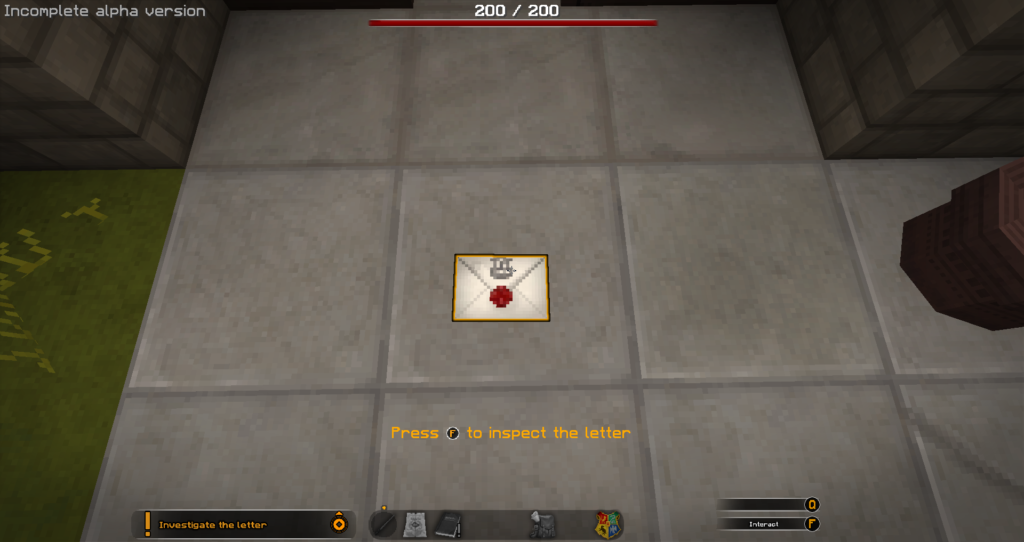
Expecting to be delivered pretty quickly to Hogwarts, I was surprised immediately by the immense scope of what is, at the end of the day, a fan-made project built in Minecraft. I quickly moved on from my home at Privet Drive, taking the Knight Bus to a custom-built London, the accuracy of which I can’t begin to gauge (though it looks very pretty for sure). From here, we traveled first to the Leaky Cauldron pub, London’s gateway to Diagon Alley, the urban shopping district of Wizarding-World England.
It was our time in Diagon Alley that most firmly readied us for the level of effort and attention to detail that exists throughout the map. Not only is Diagon Alley impressive in its accuracy against the source material, it’s captivating as a game space. Shopkeepers can be interacted with and sell items related both to gameplay and the world we’re now fully-immersed in. Quests keep us tethered to our objective of moving forward while encouraging us to explore. And finally, like the games that came before it, enchanted-padlocks, magical plants, and pitch-black corridors act as progression gates, locking some content behind abilities to be unlocked on a later visit.
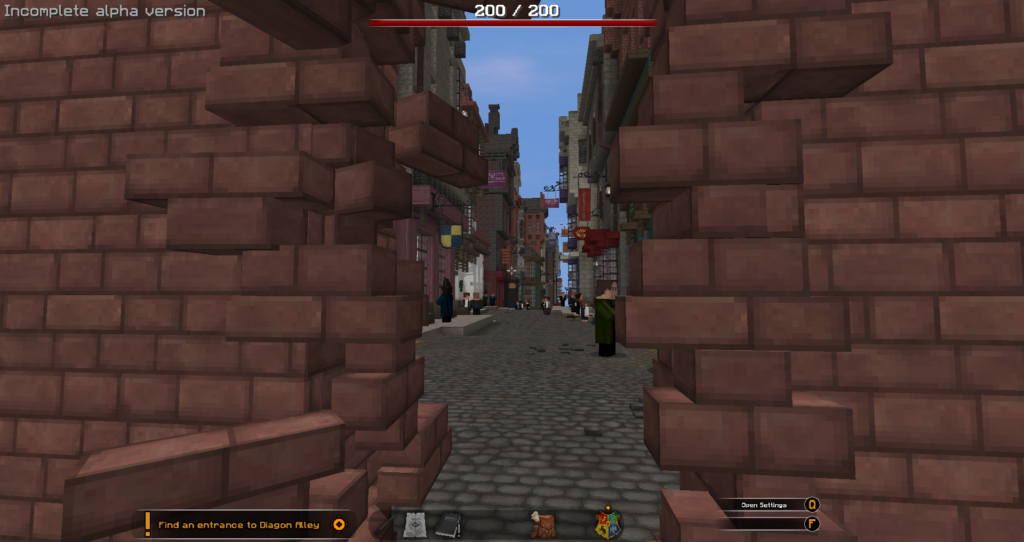
At this point, we all agreed that, were this where the project ended, we’d be thoroughly impressed and happy with the time we spent in it. But it’s not where it ended, not even close.
From Diagon Alley, once we’d gathered our school supplies and explored Gringotts and the Weasley Twins’ joke shop to the greatest extent of our curiosity, we returned to London with the objective of traveling now to King’s Cross Station to find the fabled-and-familiar Platform 9 ¾ and the Hogwarts Express. We took off on a (jump-addled) sprint through the streets of London, an experience that felt very much like the real thing to the senses of three people who had never been there.
Eventually, we reached the station and enjoyed our own experience of running through the wall to be transported to the platform-between platforms amid the bustling experience of the loading of the soon-to-be-departed train. Here, we completed a side quest for Neville Longbottom (who had lost his toad) in the form of a parkour jumping puzzle – remember, at the end of the day, this is a Minecraft map – secured our spots in one of the locomotive’s compartments, and were on our way.

The train left us at Hogsmeade Station a short walk away from Hogwarts’s Black Lake, where a fleet of boats waited to carry us to the massive castle on its opposite shore. If the majesty of the Wizarding School wasn’t evident from this vantage point (perhaps subject to Minecraft’s limited chunk generation), the in-game cutscene that played as we approached ensured that the grandeur of accurately-sculpted turrets and corridors wasn’t lost on us.
In any other title, the existence of a cutscene would be nothing to write about – in 2020 it might be a little annoying, depending on the title – but remember, as if I’d let you forget, that this isn’t a game or a mod. This is all built with tools native to the consumer version of Minecraft. For those more intimately familiar with the game’s command blocks and innate capacity for modification, this might not be as impressive as it is to me, but still, I appreciated it as yet another element that could easily be marked unnecessary. Put me in a Minecraft boat and let me row to the castle on my own and I’m content. Let me forget once more that this is Minecraft and instead take another few seconds to immerse me and I’m all the more sold.
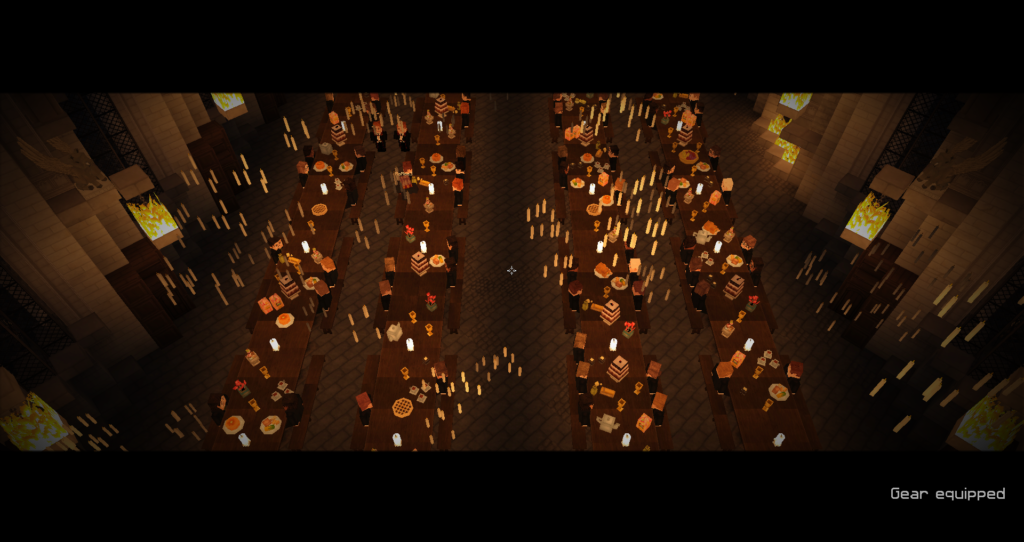
My own musings aside, we landed at the boathouse and made our way, under cover of darkness, up to the castle. Inside the Great Hall, we waited, feeling perhaps all too giddy for our combined age of nearly 70, for our chance to meet with the Sorting Hat and answer some Pottermore-style questions to be sorted into our respective houses. (A note for ardent fans of the Potter universe who are as deeply-convinced as we all were that we know which house we belong in: the questions are by no means vague and allow for easy manipulation. If you know, you’ll know… y’know?)
Once sorted into Ravenclaw, Slytherin, and Gryffindor respectively, we were transported individually to our own Common Room dormitories. We chose here to explore independently for a moment and to gather at a central point after a while, but reconnecting later on was made easy through the Marauder’s Map, an in-game fast travel system which allowed us to return to places we’d already discovered.
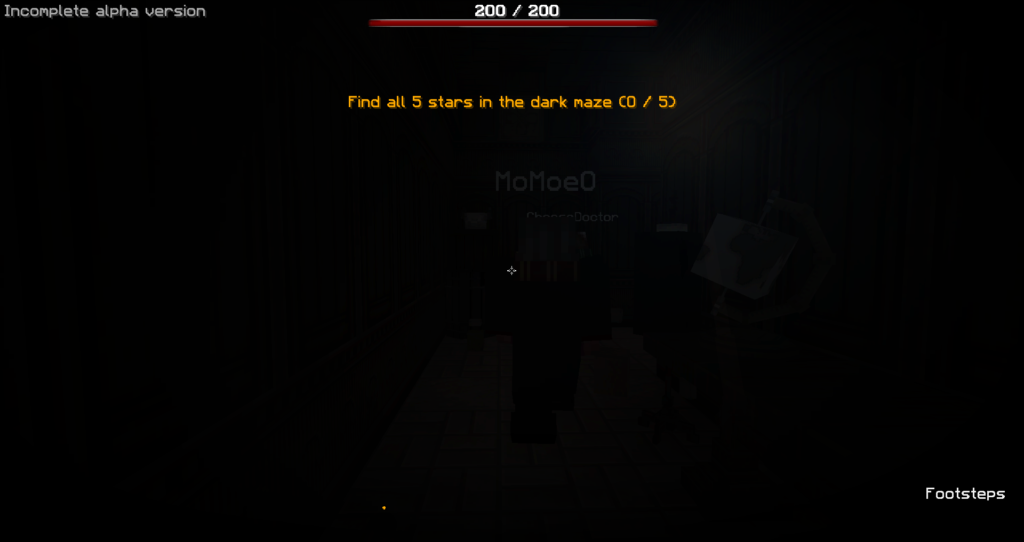
From here, we attended our first lecture, learning the light-producing charm Lumos from the diminutive Professor Flitwick. The spell, produced at-will from our own wands (themselves products of Garrick Olivander himself) to light up otherwise pitch-black corridors. To acclimate ourselves to this new ability, we were placed in a challenge course, a maze whose style imitated the spell challenges of Harry Potter games prior. Tasked with finding five floating challenge stars within the course of the maze (of which I independently located a stunning zero before getting lost and taking twice as long as anyone else to escape – the Triwizard Tournament would’ve made me a goner) and returning to Flitwick, we (they) made short time of the quest and made our way back to the castle’s halls and onto our next class.
The order of our next few lectures escapes me now, but I remember attending a Potions class with Professor Snape in which we learned how to craft health potions, a Defense Against the Dark Arts class with Professor Lupin which taught us the offensive stunning spell Stupefy, and another Charms lecture to learn Braccium Emendo, the spell (of dubious reliability) introduced by Gilderoy Lockhart in Chamber of Secrets to mend erase a bone in Harry’s arm. Here, it’s used as an Area-of-Effect healing charm. Each of these (with the exception of the Potions lecture) came with its respective challenge course, where we learned the field application of the spell, attacking monsters and targets with Stupefy or using Braccium Emendo to heal ourselves from otherwise-certain death (which, in my case, was still-certain death).

At this point, somewhere between 3 or 4 AM, we deviated from the quest line set before us and opted toward exploration. We wandered the detailed corridors of Hogwarts, finding classrooms, entering each other’s house common rooms, stumbling upon the Chamber of Secrets (for which we were greatly unprepared) and traveling down to a wintry Hogsmeade to wander around the magical village’s shops, complete a couple side quests, and judge the authenticity of another section of the game set outside the title’s School of Witchcraft and Wizardry (if you’re wondering how our judgments panned out, go ahead and reread this whole piece – the quality at all levels here is absolutely consistent).
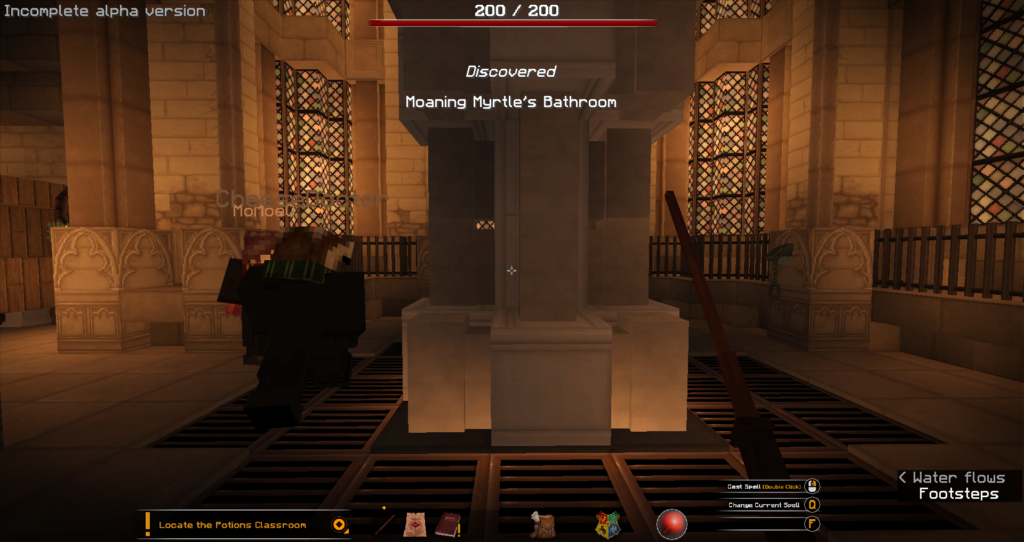
It was in Hogsmeade that we parted ways and said good night, all tired and dreading the impact on our sleep schedules going forward.
We have yet to complete our journey through Minecraft‘s rendition of Hogwarts. We may start again soon with another friend, ready to experience everything we’ve seen so far anew and everything we haven’t with baited breath.
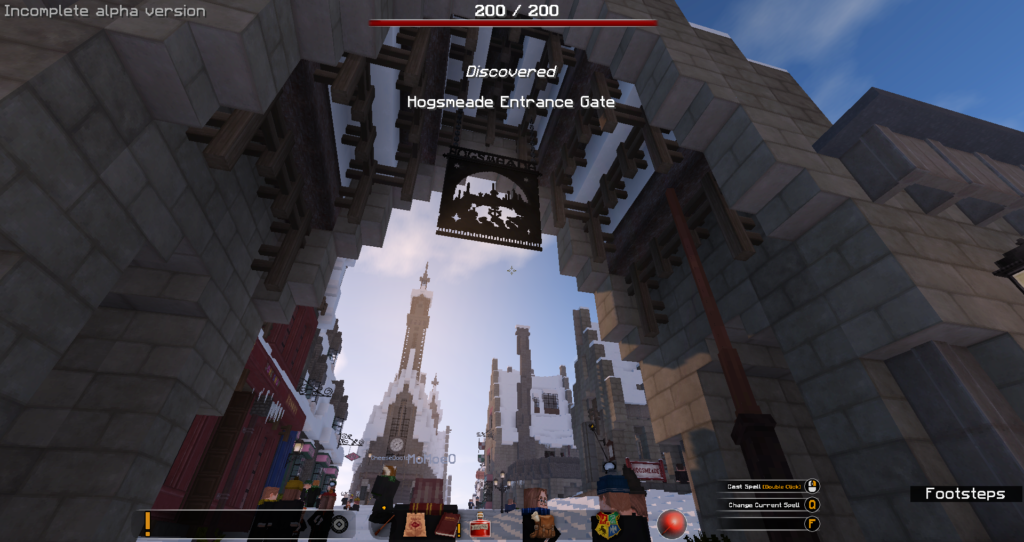
If you haven’t yet ventured into Hogwarts in its fan-made form, this may be just about the perfect time. The version we played was an Alpha build of the map, which is now set to release this Sunday through the Floo Network’s website. If you’re even a casual fan of Harry Potter and have access to a PC copy of Minecraft, I can’t recommend the experience enough. If you’ve got a set of interested friends or you’re a more hardcore fan of the series, you’ll enjoy it that much more. One of my favorite things about the experience was that it played as much like a massively-scoped sequel to the classic games as I could expect from a Minecraft map, and I found myself enraptured and thoroughly entertained the whole time. What’s more is that, through visual clues like an unfinished spell list and the still-locked locations of the Marauder’s Map, I could tell that, in our hours-long play session, we’d still only scratched the surface of this wickedly-impressive creation.
Download the Map at the Floo Network Discord Server: https://discord.gg/FsVvfEh
Also: Read my piece where I write about the absolute classic Harry Potter and the Leopard Walk Up to Dragon.
